
May is: Melanoma/Skin Cancer Detection & Prevention Month
May is skin cancer awareness month. Skin cancer is the most common cancer in the United States and one in five of us will develop skin cancer in our lifetime. Like many other cancers, successful treatment of skin cancer depends on early detection. This means that spreading awareness of skin cancer prevention and detection can be truly lifesaving.
Skin cancers fall into two main categories. There are carcinomas of the basal cells or squamous cells which are the two most common skin cancer types. These are dangerous conditions that should be taken seriously but fortunately, they are highly treatable and rarely cause death. The other main skin cancer type is melanoma which occurs in the pigment-producing cells of the skin call melanocytes. Melanomas cause most skin cancer deaths.
Dr. Aloys L Tauscheck MD, JD, a dermatologist at Paragon Medical Center, says, “Detecting skin cancer in the early stages greatly increases our ability to successfully treat the cancer.” In fact, when detected early, the five-year survival rate for melanoma is 98 percent. Dr. Tauscheck adds, “In order to detect these cancers early it is a good idea to have annual exams with your dermatologist and to consider regular self-checks or partners can check each other. This is important since most melanomas occur on our back.”
Dr. Tauscheck says, “Checking yourself or your partner for melanoma means examining skin spots and moles for certain characteristics.” Dermatologists have developed a handy, easy to remember ABCDE rule that we can use to identify potential problem spots. If you or your partner have a spot that matches one or more of the rules below be sure to call your dermatologist: ● A - Asymmetry - when one half of the spot differs from the other. ● B - Border - when the spot has a border that is irregular or scalloped, or poorly defined. ● C - Color - when the spot varies in color. ● D - Diameter - when the spot is greater than 6 mm across or, in other words, wider than a pencil eraser. ● E - Evolving - when the spot is changing color, shape, or size over time.
Dr. Tauscheck says, “Different skin types have different levels of risk for skin cancer. While those with skin that is very light are at the greatest risk, all skin types carry some risk. Those individuals with dark skin can and do develop skin cancer, including some of the more dangerous melanomas.” This makes skin cancer prevention important for everyone. Here are some skin cancer prevention pointers from the Centers for Disease Control: ● Seek the shade during midday sun ● Use hats and long sleeve clothing ● Use broad-spectrum sunscreen at SPF 15 or higher ● Avoid indoor tanning
By spreading the news about prevention and early detection we improve everyone’s chance of avoiding skin cancer or detecting it early when it is much more easily treated.
SOURCES: https://www.skincancer.org https://www.aad.org https://www.cdc.gov/cancer/dcpc/resources/features/skincancer/index.htm



